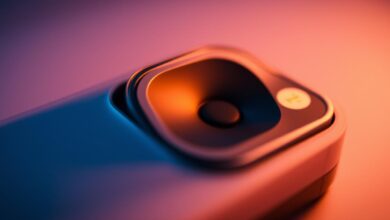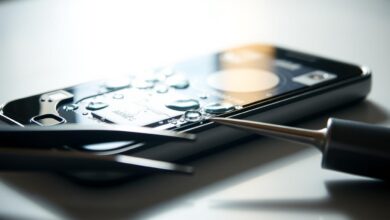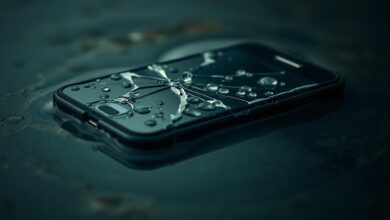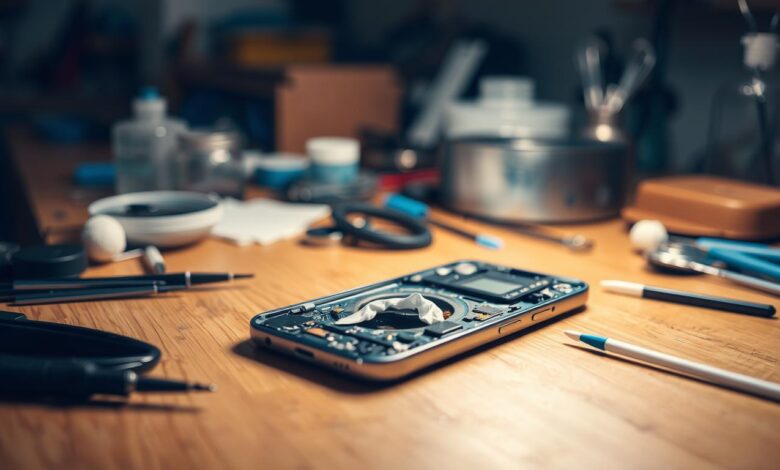
Accidentally dropping your phone in water can be a stressful experience. You might worry if your device can be salvaged. Water damage is a common reason phones fail. Knowing how to fix it can help a lot in repairing your phone.
It’s important to know how to handle a wet phone. Water damage can cause small problems or make your phone not work at all. We’ll look at the best ways to fix a water-damaged phone. This includes what to do right away and when to see a pro.
Key Takeaways
- Immediate actions to take when your phone gets wet
- Methods to dry out your phone
- Signs that your phone needs professional repair
- Options for water damage phone repair
- Tips to prevent water damage in the future
Understanding the Dangers of Water Damage to Phones
When your phone gets wet, it can lead to serious damage if not fixed fast. Water and electronics don’t mix well. This can cause big problems if you don’t act quickly.
How Water Affects Internal Components
Water can get into your phone’s parts, causing short circuits. These can badly damage the circuitry. The corrosion that follows makes fixing your phone harder.
The Difference Between Water Types (Freshwater vs. Saltwater)
The kind of water your phone gets wet in matters a lot. Saltwater, with its high salt, can damage your phone more than freshwater. Knowing this helps you figure out how to fix your wet phone.
Timeline of Damage Progression
The longer your phone stays wet, the worse the damage gets. Corrosion can start quickly, spreading fast if not stopped. Quick action is key to reduce damage and fix your phone.
Act Fast: Immediate Steps to Take When Your Phone Gets Wet
When your phone gets wet, every second matters. Knowing the right steps can save your device. Acting fast and correctly can greatly reduce damage risk.
Power Off Your Device Immediately
The first step is to power off your phone right away. This stops short circuits that could harm the inside parts. Avoid turning it on or pressing any buttons until it’s dry.
Remove Accessories, SIM Card, and Battery (If Possible)
Take off any accessories like cases or screen protectors to help dry faster. If you can, remove the SIM card and battery. This helps prevent corrosion and damage to these important parts.
Gently Wipe Exterior Moisture
Use a soft cloth to wipe the outside of your phone. This removes visible moisture. Be gentle to avoid pushing water into the phone’s openings.
Proper Technique for Drying Ports and Openings
To dry ports and openings, use a soft-bristled brush or cotton swab. Gently remove moisture. Don’t use compressed air, as it can push water in. Instead, use desiccants or drying a phone with rice to absorb moisture.
| Immediate Action | Purpose |
|---|---|
| Power off the device | Prevent short circuits |
| Remove accessories and SIM card | Reduce risk of corrosion and damage |
| Gently wipe exterior moisture | Remove visible water |
By taking these immediate steps, you can greatly improve your phone’s recovery chances. The key is to act quickly and carefully to minimize damage.
How Can You Get Water Out of Your Phone: The Essential Methods
Water in your phone can cause big problems, but there are ways to dry it out. If your phone gets wet, you need to act fast to lessen the damage. There are different ways to remove water, depending on how wet your phone is and its design.
Shaking and Tilting Techniques
Shaking and tilting your phone can help get rid of water. Gently shake it to push water out of small spaces. Then, tilt it to let gravity help drain the water. This works best right after your phone gets wet.
Key steps:
- Gently shake the phone to remove loose water.
- Tilt the phone in various directions to help water drain out.
- Avoid vigorous shaking, which can push water further into the phone.
Using Compressed Air Safely
Compressed air can also remove water from your phone’s small spaces. But, you must use it carefully to avoid harming your phone.
Precautions:
- Keep the can upright to prevent liquids from coming out.
- Use short bursts of air to avoid pushing water further in.
- Maintain a safe distance to avoid damaging the internal components.
Vacuum Method for Water Extraction
The vacuum method uses a vacuum cleaner to pull out water from your phone’s ports. But, you need to be careful not to damage your phone with too much suction.
Optimal Pressure Settings for Different Phone Models
Each phone model can handle different levels of suction. For most phones, a low to moderate suction setting is best. It’s important to find the right pressure for your phone to avoid damage.
General guidelines:
- For most phones, start with the lowest suction setting.
- Gradually increase the suction power if necessary, while monitoring for any signs of damage.
- Consult your phone’s manual or manufacturer’s website for specific guidance.
By using these methods, you can remove water from your phone and possibly save it from damage. The key is to act fast and be gentle to prevent more harm.
The Rice Method: Does It Really Work?
Drying a phone with rice is a common fix, but its success is uncertain. The idea is that rice absorbs moisture from the phone, saving it from water damage.
The Science Behind the Rice Technique
Rice is great at soaking up moisture, which is why it’s used to keep things dry. The idea is that rice can dry a wet phone. But, how well it works depends on how wet the phone is and the type of rice.
Proper Steps for Using Rice
To dry a phone with rice, follow these steps:
- Turn off your phone immediately.
- Remove any accessories, SIM card, and battery (if possible).
- Gently wipe the exterior with a soft cloth.
- Fill a container with uncooked rice.
- Bury your phone in the rice, ensuring it’s fully covered.
- Leave it for at least 48 hours.
Limitations and Misconceptions
The rice method can work, but it’s not perfect. Rice might not reach water inside the phone. Also, rice dust can harm the phone’s ports.
Research and Expert Opinions on Rice Effectiveness
Experts have mixed views on using rice to dry phones. Some say it’s better than nothing, while others doubt its effectiveness. A study suggests it can help if done right and quickly.
| Method | Effectiveness | Risks |
|---|---|---|
| Rice Method | Moderately Effective | Rice Dust Damage |
| Silica Gel | Highly Effective | Low Risk |
| Compressed Air | Less Effective | Potential for Further Damage |
In summary, the rice method can help dry a wet phone, but it has its limits and risks. Knowing these can help you use it better and increase your phone’s chances of survival.
Better Alternatives to Rice for Drying Your Phone
Many people use rice to dry a wet phone, but there are better options. Rice can soak up moisture, but it’s not the fastest way to dry your phone. Let’s look at some better ways to fix a wet phone.
Silica Gel Packets
Silica gel packets are great at pulling moisture out of the air. You can find them in packaging for electronics and shoes. To dry your phone, put it in a container with several packets around it. This method is especially good for wet phone repair because it gets rid of moisture quickly.
Commercial Desiccants
Commercial desiccants are made to control humidity and soak up moisture. They work better than rice and can be used again. To fix a wet phone, put it in a sealed container with a desiccant. Follow the product’s instructions for the best results.
Uncooked Instant Oatmeal
Uncooked instant oatmeal is also a good desiccant for drying phones. It’s better than regular rice because it has a bigger surface area. To use oatmeal, fill a container with it and bury your phone in it. Make sure your phone is fully covered.
Crystal Cat Litter
Crystal cat litter is made to soak up moisture and smells. It’s best to use the non-clumping, crystal type. Place your phone in a container filled with crystal cat litter, making sure it’s fully covered.
Each of these alternatives has its own benefits. The right choice depends on what you have available and your preference. Using one of these methods can help fix your wet phone.
Using Drying Agents Effectively
Using drying agents is key to fixing a water damaged phone. When your phone gets wet, moisture can harm the inside parts. Drying agents soak up this moisture, helping your phone recover.
Creating a Proper Drying Environment
To dry your phone well, you need the right setup. Put your phone in a sealed container with the drying agent. This keeps moisture out. Silica gel packets work great because they soak up a lot of moisture.
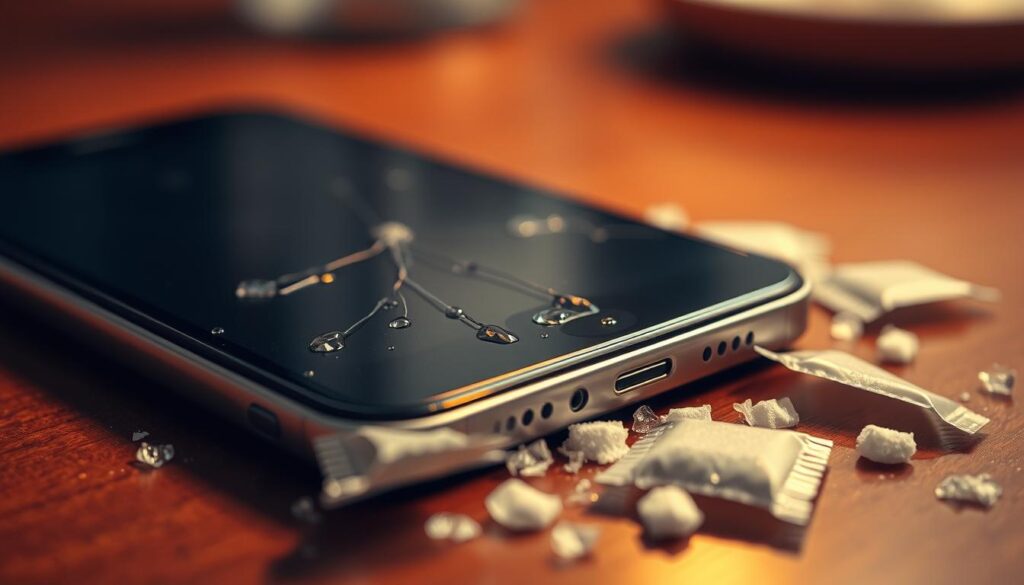
How Long to Leave Your Phone in Drying Agents
How long to dry your phone depends on a few things. Usually, leave it for 24 to 48 hours. But, it really depends on how wet it was and the drying agent used.
Signs That Drying Is Complete
It’s hard to know when your phone is dry. Look for signs of moisture. Check for corrosion or mineral deposits inside.
Testing for Residual Moisture
To check for moisture, use a few methods. Look for a moisture indicator if your phone has one. Or, see if the screen and other parts work after drying.
By following these steps and using drying agents right, you can fix a water damaged phone.
Professional Water Damage Repair Options
Phone water damage can be scary. Often, the best thing to do is get a professional to fix it. DIY fixes might work for small problems, but serious damage needs a pro.
When to Seek Professional Help
If your phone was underwater for a long time or DIY fixes didn’t work, get help. Look for corrosion, constant moisture, or if your phone doesn’t work right.
What to Expect from Repair Services
First, a pro will check your phone’s damage. They’ll tell you how much it will cost to fix it. Good services also offer a warranty, so you can relax.
Average Cell Phone Water Damage Repair Costs
Repair costs vary a lot. It depends on your phone, how bad the damage is, and who fixes it. Here’s what you might pay:
- Screen repairs: $50-$150
- Logic board repairs: $100-$300
- Water damage cleaning and drying: $30-$100
Finding Reputable Repair Services
Look for repair services with:
- Good reviews and ratings
- Experience with your phone model
- A warranty on their work
- Clear prices and how they check your phone
Choosing a reliable service means your phone will be fixed right.
DIY Cleaning for Water-Damaged Phones
If you’re good at DIY repairs, you can try cleaning a water-damaged phone. But, be careful not to make things worse.
Tools and Materials You’ll Need
To clean your phone, you’ll need some special tools and materials. You’ll need a Phillips screwdriver, a soft-bristled brush, a microfiber cloth, and isopropyl alcohol (at least 90% concentration). Also, get a desiccant or silica gel packets to dry the phone.
Make sure the tools fit your phone’s make and model. Some phones might need a Pentalobe screwdriver instead of a Phillips.
Step-by-Step Cleaning Process
- Take apart your phone as much as you can, removing the SIM card, SD card, and other parts.
- Use a soft-bristled brush to gently remove any debris or corrosion from the circuit boards and parts.
- Dampen a microfiber cloth with isopropyl alcohol and wipe down the parts carefully. Don’t let any liquids get inside the phone.
- Use the microfiber cloth to dry the parts well.
- Put the phone and its parts in a container with a desiccant or silica gel packets to dry out any moisture left.
Safety Precautions During DIY Repair
When doing a DIY repair, it’s important to be careful to avoid damaging your phone or getting hurt.
Handling Sensitive Components
Be very careful when handling sensitive parts like the circuit board. Static electricity can harm these parts. To prevent this, ground yourself by touching a metal object or wearing an anti-static wrist strap.
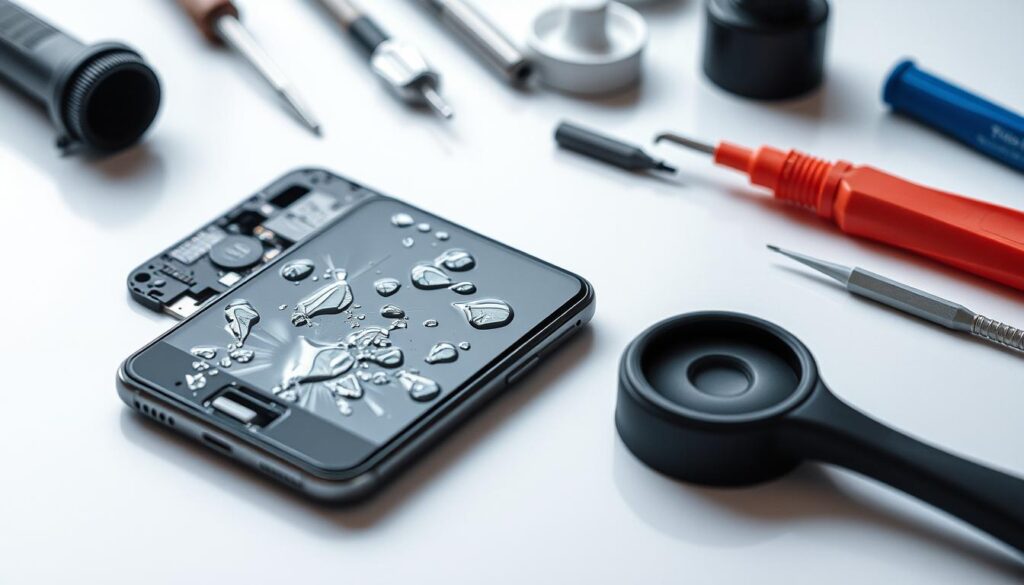
| Component | Precaution | Tool/ Material |
|---|---|---|
| Circuit Board | Avoid static electricity | Anti-static wrist strap |
| Display | Handle with care to avoid scratches | Microfiber cloth |
| Battery | Check for corrosion | Isopropyl alcohol |
Special Considerations for Different Phone Models
Knowing your phone’s unique features is key to fixing water damage. Each phone model has its own design and features. These affect how it handles water and the best ways to fix it.
iPhone Water Damage Solutions
iPhones have special weak spots like the SIM card slot and charging port. If your iPhone gets wet, act fast and carefully. Apple says not to charge it until it’s dry.
Android Phone Water Removal Techniques
Android phones have different designs, but similar steps can help. Start by removing the SIM card and shaking out water. Use a soft cloth to dry the outside. Some Androids have water resistance, so that’s important to remember.
Waterproof Phones: What to Do When Water Gets Inside
Even waterproof phones can let water in under certain conditions. If water gets in, dry it out as much as you can. Check for damage to seals or inside parts.
Model-Specific Vulnerabilities
Each model has its own weak spots. For example, some iPhones are more likely to get damaged by water. Certain Androids have their own issues. Knowing these helps fix your phone better.
| Phone Model | Common Water Ingress Points | Recommended Repair Approach |
|---|---|---|
| iPhone | SIM card slot, charging port | Professional repair or AppleCare |
| Android | Varies by model; often SIM card slot, USB-C port | DIY drying methods or professional repair |
| Waterproof Phones | Seals and ports | Inspect seals, dry thoroughly, professional check-up |
Insurance and Warranty Considerations
Insurance and warranties are key in handling water damage repair costs for phones. Knowing your coverage can lessen the financial hit from accidents.
Does AppleCare Cover Water Damage?
AppleCare+ covers up to two accidents, including water damage, for iPhones and Apple Watches. But, there’s a fee for each incident. Make sure to check AppleCare+ terms to know what’s included.
Carrier Insurance Policies for Water Damage
Many carriers have insurance for accidental damage, like water damage. Each carrier’s policy is different. It’s important to look at your plan’s details. Some carriers might offer extra coverage or need you to buy a separate policy.
Documenting the Damage for Claims
When filing a claim for water damage, detailed documentation is crucial. Take clear photos of the damage and keep repair estimates. Any other evidence is also important. This helps support your claim and makes the process smoother.
Third-Party Insurance Options
There are also third-party insurance options for phone damage, including water damage. Companies like Asurion and SquareTrade offer plans. These can be bought separately from your carrier’s insurance. It’s good to compare these to find the best one for you.
To understand the costs of fixing water damage on phones, here’s a comparison table:
| Phone Model | Average Repair Cost | Insurance Coverage |
|---|---|---|
| iPhone 13 | $250-$350 | AppleCare+, Carrier Insurance |
| Google Pixel 6 | $200-$300 | Carrier Insurance, Third-Party |
| Samsung Galaxy S22 | $300-$400 | Carrier Insurance, Third-Party |
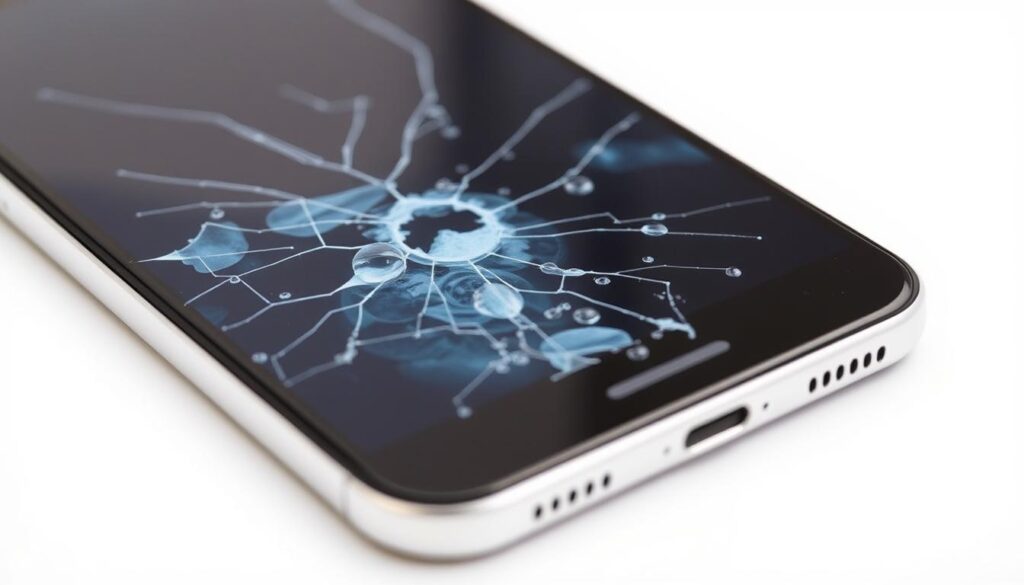
It’s vital to understand your insurance and warranty options for water damage repairs. Knowing what’s covered and how to document damage can help reduce the financial impact of accidents.
Recovering Data from a Water-Damaged Phone
When your phone gets wet, you risk losing your data. Water damage can cause data loss right away or over time. This depends on how much water it got and the damage inside the phone.
Backup Options After Water Exposure
If your phone still works after getting wet, back up your data right away. Use cloud storage or connect it to a computer to save files on an external hard drive. If it won’t turn on, you might need professional help to get your data back.
Professional Data Recovery Services
Professional data recovery services can help with water-damaged phones. They have special tools to get data from phones that won’t work. Choose a service with experience in water damage and a good success rate.
Preventative Measures for Data Protection
To avoid data loss, take steps to protect your data. Back up your phone’s data regularly. Use automatic backup features or manually save to cloud storage or an external drive.
Cloud Storage Solutions
Cloud storage like Google Drive, iCloud, or Dropbox is great for backups. They sync your data to the cloud, so you can get to it from any device. This way, your data is safe, even if your phone is damaged.
Knowing how to back up your data and having a plan can help. This way, you can reduce the chance of losing important info if your phone gets water damage.
Signs Your Phone Is Suffering from Water Damage
Spotting water damage early can help save your phone. It’s key to act fast when your phone gets wet.
Visual Indicators of Water Damage
Start by looking for signs of water damage. Corrosion, water spots, or a Liquid Damage Indicator (LDI) change can mean trouble. If you see rust or mineral deposits, water damage is likely.
Performance Issues Related to Moisture
Water damage can also show up in how your phone works. Look out for random shutdowns, slow charging, or distorted audio. If your screen acts weird or doesn’t respond right, moisture might be the cause.
Using Water Damage Indicators on Your Device
Many phones have built-in water damage indicators. For example, iPhones have an LDI that turns red or pink when wet. Checking these can tell you if your phone has been damaged by water.
Long-Term Effects of Untreated Water Exposure
Ignoring water damage can cause big problems. It can lead to permanent screen damage, corrosion of internal components, or even complete device failure. Knowing these risks is why you should act fast when your phone gets wet.
| Signs of Water Damage | Description | Potential Consequences |
|---|---|---|
| Visual Corrosion | Rust or mineral deposits on internal components | Permanent damage to components |
| Performance Issues | Random shutdowns, slow charging, distorted audio | Disruption in phone functionality |
| LDI Color Change | Change from white/silver to red/pink | Indication of water exposure |
What Not to Do When Your Phone Gets Wet
When your phone gets wet, it’s just as important to know what not to do as it is to know how to fix it. Many people accidentally make things worse by using the wrong ways to dry their phones. Knowing these mistakes can really help your chances of wet phone repair.
Common Mistakes That Cause Further Damage
One big mistake is trying to turn on your phone right after it gets wet. This can lead to short circuits and more damage. Another error is not taking off accessories, SIM cards, or batteries (if you can), as they can hold water inside.
- Not powering off the device immediately
- Failing to remove phone cases and SIM cards
- Using heat sources to dry the phone
Harmful Drying Methods to Avoid
Some drying methods can actually harm your phone more than help. For example, using a hair dryer or microwave can damage the inside parts. Learn more about saving a wet cell with safe and effective methods.
Why Heat Sources Are Dangerous
Heat sources can damage your phone’s internal parts. This is because different materials expand at different rates when heated. This can cause cracks or dislodging connections.
Myths About Phone Drying Debunked
A common myth is that drying a phone with rice works well. While rice can soak up moisture, it’s not the best method. It can leave behind dust or starch residue that can harm your phone.
By avoiding these mistakes and harmful drying methods, you can boost your chances of successful wet phone repair. It’s crucial to be careful and informed when dealing with water damage to help your phone survive.
Conclusion: Giving Your Water-Damaged Phone the Best Chance of Survival
Dealing with a water-damaged phone can be stressful. But, knowing the right steps can help a lot. It’s important to dry your device right and know when to get help.
Acting fast and using the right methods can save your phone. This guide has shown you how to get water out of your phone. We’ve talked about simple methods and using drying agents like silica gel packets.
It’s key to avoid mistakes that can harm your phone more. Don’t use heat or turn on your phone too soon. If your phone is badly damaged, getting professional help might be best.
Being informed and ready can reduce damage and maybe save your phone. Whether it’s a recent spill or you just want to be ready, knowing what to do can give you peace of mind. It can also help your phone last longer.
FAQ
How can I dry out my phone after water damage?
To dry your phone, try using rice, silica gel packets, or commercial desiccants. It’s key to act fast and follow the right steps to lessen damage.
Is it worth repairing a water-damaged phone?
Whether to repair a water-damaged phone depends on the damage’s extent and repair cost. If the damage is minor and the repair is affordable, fixing it might be a good choice. But if the damage is severe, it could be cheaper to get a new phone.
How much does water damage phone repair typically cost?
Repair costs vary based on your phone model, damage level, and repair service. Prices usually range from to 0 or more, depending on the repair’s complexity.
Can I fix water damage on my phone myself?
Yes, you can try fixing water damage yourself with DIY methods. This includes cleaning internal parts, using drying agents, and replacing damaged components. But if you’re not sure or the damage is severe, it’s best to get professional help.
How can I prevent water damage to my phone in the future?
To avoid water damage, use a waterproof case, stay away from water, and be careful near it. Also, backing up your data regularly can help lessen the impact of water damage.
Does AppleCare+ cover water damage?
Yes, AppleCare+ covers up to two incidents of accidental damage, including water damage, for a fee. Always check your AppleCare+ coverage terms to know what’s included and what’s not.
How can I recover data from a water-damaged phone?
To recover data, use professional services or restore from a backup if you have one. It’s important to act fast and avoid using the phone until data is recovered to prevent more damage.
What are the signs that my phone has water damage?
Signs include corrosion, mineral deposits, or water spots, and performance issues like slow charging or camera problems. Also, check for water damage indicators on your device to see if it’s been exposed to water.
